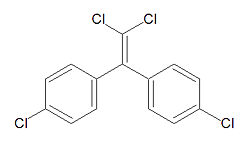DDT: Difference between revisions
imported>Milton Beychok m (Fixed link) |
mNo edit summary |
||
| (5 intermediate revisions by 4 users not shown) | |||
| Line 1: | Line 1: | ||
{{subpages}} | {{subpages}} | ||
{{Image|DDT DEVolk.jpg|right|250px|Structure of DDT.}} | |||
'''DDT''', abbreviated from '''Dichloro-diphenyl-trichloroethane''', but correctly called by its IUPAC name '''1,1,1-trichloro-2,2-bis(4-chlorophenyl)ethane''' is an organochlorine pesticide that is very effective at killing [[ | '''DDT''', abbreviated from '''Dichloro-diphenyl-trichloroethane''', but correctly called by its IUPAC name '''1,1,1-trichloro-2,2-bis(4-chlorophenyl)ethane''' is an organochlorine pesticide that is very effective at killing [[mosquitoe]]s and was used effectively in the fight against [[malaria]].<ref>http://www.aaenvironment.com/DDT.htm</ref> | ||
The campaign against DDT was started by [[Rachel Carson]] with her book [[Silent Spring]]. While DDT itself is safe, DDT breaks down into [[DDE]](dichlorodiphenyldichloroethylene) and [[DDD]](dichlorodiphenyldichloroethane).<ref>http://www.eco-usa.net/toxics/ddt.shtml</ref> DDE has been classified as a possible carcinogen by the [[EPA]].<ref>http://www.epa.gov/ttn/atw/hlthef/dde.html</ref> | The campaign against DDT was started by [[Rachel Carson]] with her book [[Silent Spring]]. While DDT itself is safe, DDT breaks down into [[DDE]](dichlorodiphenyldichloroethylene) and [[DDD]](dichlorodiphenyldichloroethane).<ref>http://www.eco-usa.net/toxics/ddt.shtml</ref> DDE has been classified as a possible carcinogen by the [[EPA]].<ref>http://www.epa.gov/ttn/atw/hlthef/dde.html</ref> | ||
| Line 8: | Line 8: | ||
DDT was banned in 1972 by the [[Environmental Protection Agency]] under Administrator William Ruckelshaus, but it is still used in some countries.<ref>http://www.aaenvironment.com/DDT.htm</ref> | DDT was banned in 1972 by the [[Environmental Protection Agency]] under Administrator William Ruckelshaus, but it is still used in some countries.<ref>http://www.aaenvironment.com/DDT.htm</ref> | ||
[[ | ==Legacy== | ||
The use of DDT along the [[Saint Lawrence River]] valley continues to have an impact the river's [[Beluga whales]], though the chemical has long been banned. <ref>{{cite news |title=Pollution stunts Canada's beluga whales |url=http://afp.google.com/article/ALeqM5jFNuKlEL6QfLbIjr4RrGq1AvweCQ |work=Agence France Presse |date=2007-09-02 |accessdate=2008-02-06 }}</ref> | |||
{{Image|DDE DEVolk.jpg|right|250px|Structure of DDE.}} | |||
{{Image|DDD DEVolk.jpg|right|250px|Structure of DDD.}} | |||
==References== | |||
{{reflist}}[[Category:Suggestion Bot Tag]] | |||
Latest revision as of 06:01, 4 August 2024
DDT, abbreviated from Dichloro-diphenyl-trichloroethane, but correctly called by its IUPAC name 1,1,1-trichloro-2,2-bis(4-chlorophenyl)ethane is an organochlorine pesticide that is very effective at killing mosquitoes and was used effectively in the fight against malaria.[1]
The campaign against DDT was started by Rachel Carson with her book Silent Spring. While DDT itself is safe, DDT breaks down into DDE(dichlorodiphenyldichloroethylene) and DDD(dichlorodiphenyldichloroethane).[2] DDE has been classified as a possible carcinogen by the EPA.[3]
DDT was banned in 1972 by the Environmental Protection Agency under Administrator William Ruckelshaus, but it is still used in some countries.[4]
Legacy
The use of DDT along the Saint Lawrence River valley continues to have an impact the river's Beluga whales, though the chemical has long been banned. [5]
References
- ↑ http://www.aaenvironment.com/DDT.htm
- ↑ http://www.eco-usa.net/toxics/ddt.shtml
- ↑ http://www.epa.gov/ttn/atw/hlthef/dde.html
- ↑ http://www.aaenvironment.com/DDT.htm
- ↑ Pollution stunts Canada's beluga whales, Agence France Presse, 2007-09-02. Retrieved on 2008-02-06.


